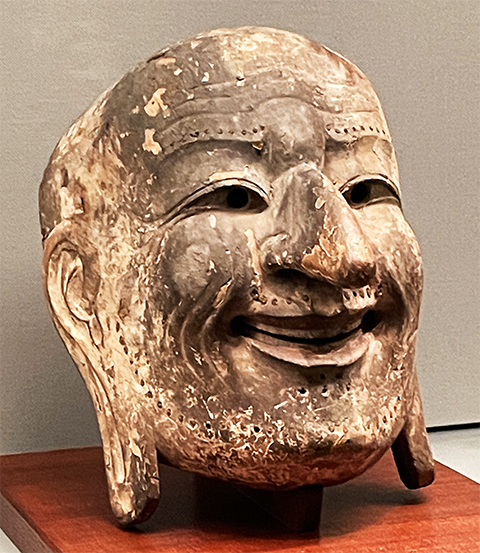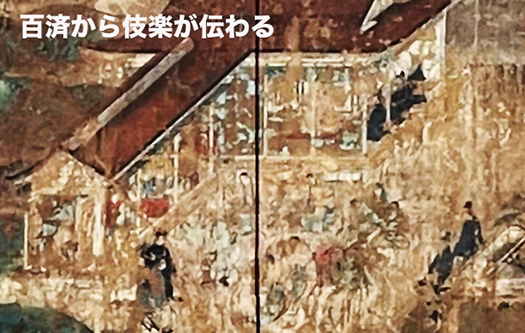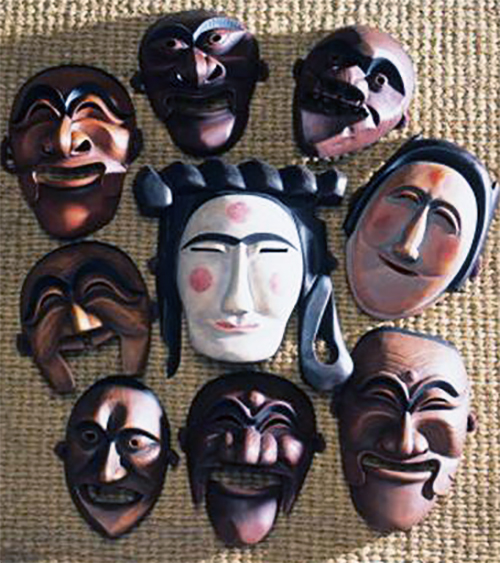

「法隆寺宝物館「聖徳太子絵伝」記事、第10回目は聖徳太子治政の当時、百済から伝わった仮面舞踏劇「伎楽」と韓国「河回村」仮面劇との関係について。
このシリーズの第一回はこちら→端正なモダニズム「法隆寺宝物館」探訪。
きのうは四天王寺建設事業で来日した金剛組のことに触れました。仏教導入ということは寺院建設が当然ワンセットで進行していく。そのことが多くの人びとにとってわかりやすい文化「革命」として聖徳太子の治政の実質を伝えたものだったのでしょう。
瓦というそれまでの日本社会では見たことのない装飾装置がその生産システムが一体となって輸入され、建築デザインとしても塔などの象徴性の高い建築がもたらされた。その寺院内では聞いたこともない宗教音楽、銅鑼や読経音声、木魚の音などが響き渡った。
そういった「世界宗教文化」をこうした仏教寺院はひとびとにわかりやすく伝えていった。日本社会はさまざまな海外との出会いを経験してきたけれど、幕末期の「黒船」以上にこの仏教・寺院との出会いは日本人社会に根底的な変革として認識されたに違いないと思います。喉元過ぎれば、ではないけれどその驚きがあまりにも巨大体験すぎて、いまやその開始時点に気付くことにも忘れているのだと思うのです。
たぶん聖徳太子の日本社会改革は明治の開国と同等以上に衝撃的だった。
そしてこの時代はそれ以外にも海外文化の導入がなされていた。その後、能などに昇華していった東アジア的な仮面劇・伎楽もそのひとつだと思います。歴史の教科書で学習した記憶はあるけれど、その後の日本社会では能などに変容していって、伎楽としては存続しなかったので印象が薄いと感じる。
なんですが、わたし的には韓国「河回村〜ハフェマウル」訪問のときに触れた仮面劇のことがまるでそっくりすぎて鮮烈な印象として蘇ってきた。


わたしのブログ過去記事で河回村〜ハフェマウルについては【東アジアの建築と人間性 韓国河回村追想-19】で取り上げていますので参照いただければ幸いです。2016年の韓国訪問でしたが2020年に書いた記事。
伎楽の仮面はひとつだけ掲載しましたが、法隆寺宝物館でこの「伎楽」の数十点と多数の仮面群を参観して韓国のこの仮面劇との強い文化的共通性を感じた次第なのです。河回村では村の入口近くにまるで結界魔除けのように木に彫像された「仮面」が置かれています。日本でも日本海文化圏の東北秋田で近似した村境の「魔除け」を見ていた。またナマハゲ文化にも繋がってくる。環日本海文化圏としての共通性を強く感じた。また2016年当時のことを思い返すと、韓国訪問から帰ってすぐに秋田に取材出張している・・・。
そういった文化交流の生きた見本体験のように感じた次第ですが、その上さらに聖徳太子絵伝にもいわば証拠として発見できたことから、まことに目の覚めるような思いをしています。
凡人でもながく「建築と歴史・文化」の接点で探訪し続けていると、思わぬ「符合」が訪れてくれるものかも知れません。こういう機縁を大事にしたい。
English version⬇
“Gigaku” and the Korean “Hahoe Village” Mask Play: The Gallery of Horyuji Treasures-10]
The Sea of Japan Rim Cultural Area, Korea and Japan, and the mask culture of Namahage and “Noh” that remains in Akita. Masked drama in an ancient Korean village. A planetary direct line of coverage experience…
In this 10th article of the “Illustrated Biography of Prince Shotoku” series from the Gallery of Horyuji Treasures, we look at the relationship between Gigaku, a masked dance drama introduced from Baekje during the reign of Prince Shotoku, and the masked drama of Hahoei Village in Korea.
Yesterday, I mentioned the Kongo Corporation, which came to Japan for the Shitennoji temple construction project. The introduction of Buddhism naturally meant that the construction of temples proceeded as one set. This must have been an easy-to-understand cultural “revolution” that conveyed the substance of Prince Shotoku’s reign to many people.
Tiles, a decorative device never before seen in Japanese society, were imported along with their production system, and the architectural design of pagodas and other highly symbolic structures were also brought in. In the temples, religious music, gongs, sutra chanting, and the sound of wooden fish echoed through the air, which had never been heard before.
These Buddhist temples made it easy for people to learn about the culture of world religions. Japanese society has experienced various encounters with foreign countries, but I believe that this encounter with Buddhism and temples must have been recognized as a fundamental change in Japanese society, even more so than the “Black Ships” of the late Edo period. I think that the surprise was so great that we have forgotten how to recognize the beginning point of the transformation.
Perhaps Prince Shotoku’s reform of Japanese society was as shocking or more so than the opening of the country to the outside world in the Meiji era.
And other foreign cultures were also introduced in this period. I think that East Asian-style masked drama and gigaku, which later sublimated into Noh and other forms, is one such example. I remember learning about it in history textbooks, but I feel that I have little impression of Gigaku because it was transformed into Noh and did not survive as Gigaku in Japanese society after that.
However, for me, the masked drama that I saw during my visit to Hahoe Village in Korea was so similar that it came back to me as a vivid impression.
I wrote about Hahoe Village in my previous blog post [Architecture and Humanity in East Asia: A Reminiscence of Hahoe Village in Korea – 19].
I have only shown one Gigaku mask here, but I visited the Horyuji Treasure Museum and saw dozens of Gigaku masks and many other masks, and felt a strong cultural similarity with the Korean masked theater. In Hahoe Village, wooden masks are carved near the entrance to the village as if to ward off evil spirits. In Japan, too, I saw “amulet” at the village boundary approximated in Tohoku Akita in the Sea of Japan cultural area. It is also connected to the Namahage culture. I strongly felt the commonality as a Japan Sea Rim cultural area. Also, thinking back to 2016, I went to Akita on a research trip immediately after returning from my visit to South Korea….
I felt as if I was experiencing a living example of such cultural exchange, and on top of that, I was able to find evidence of this in a picture biography of Prince Shotoku, which was truly an eye-opening experience.
Even an ordinary person may find unexpected coincidences when he or she continues to explore the connection between architecture, history, and culture. I would like to cherish these opportunities.
Posted on 6月 7th, 2023 by 三木 奎吾
Filed under: 日本社会・文化研究, 歴史探訪







コメントを投稿
「※誹謗中傷や、悪意のある書き込み、営利目的などのコメントを防ぐために、投稿された全てのコメントは一時的に保留されますのでご了承ください。」
You must be logged in to post a comment.